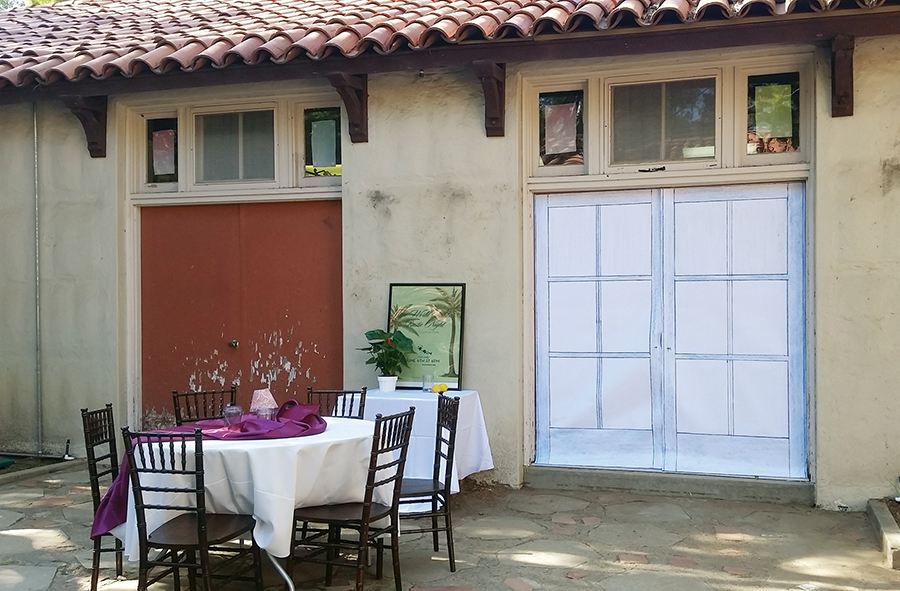The courtyard in the historic Rustic Canyon Park clubhouse will un- dergo an appealing upgrade this summer as the initial phase of a community effort to restore the building to its former 1920s glory.
Six sets of glass French doors (budgeted at $6,000 per set of double doors) will be installed, modeled after the original ones and replacing current doors that are in bad shape with dry rot.
“That’s what we can afford at this point, thanks to last year’s Rustic Night fundraiser,” said Veshlemoey Zwart, president of the Park Advisory Board, which is spearheading an ambitious restoration project at the park.

The remaining funds from Rustic Night will be used to refurbish the inside of the tennis pavilion, redo the electrical wiring within the pavilion and make improvements to surrounding structures.
This work is part of the Preservation Master Plan that was recently unveiled during a public presentation.
“This building is the heart and soul of Rustic Canyon,” said Louden, and Young noted that “this master plan will greatly aid us in maneuvering the ins and outs of local government to achieve our goals in preserving the clubhouse.”
New Park Director Paige Barnes welcomed more than 30 residents in attendance, a few of whom grew up in the area. Young himself is a native of Rustic Canyon and co-authored (with his mother Betty Lou) a history of the canyon.
Before recounting the history of the Spanish-style clubhouse, built by The Uplifters Club in 1923, Young introduced a descendant—Sharon Shapiro, the great-granddaughter of one of the original members and now a field deputy for City Councilman Mike Bonin.
Ironically, the “dry” Methodist founders of Pacific Palisades sold the land to The Uplifters, a rowdy bunch whose main goal was to drink with utter abandon in the era of Prohibition.
Since the original makeshift clubhouse on the property had burned down in 1922, concrete became the material of choice for the new clubhouse. Young pointed to the beams in the gym and said, “They’re actually cast out of concrete. This building was built like a tank to last.”
Architect George Taylor Louden and his staff, who specialize in historical restorations, spent close to a year creating this vital 100-page document with the generous help of local historian Randy Young and the Palisades Historical Society.
He then performed a nifty parlor trick by opening a door to reveal the original fireplace that is currently hidden and that stores sports equipment. Other gems like this might be uncovered during the restoration.
Unfortunately, the Great Depression began the unraveling of The Uplifters and by the mid-1930s the club was bankrupt. In the late 1940s, much of the surrounding land was sold off for the subdivision of Rustic Canyon.
Maybell Machris purchased the clubhouse and eight acres of land in 1953 in memory of her husband, Alfred, and generously donated ownership to the city of Los Angeles. Since then, the Department of Recreation and Parks has managed the property.
The locally prominent architectural firm of A. Quincy Jones and Fred Emmons repurposed and repaired the structure to function as a park facility in 1960. Much of their work remains in place today.
Back then, the idea of historical preservation was rarely considered. Hence the significance of this new blueprint for the clubhouse, which achieved Historical Cultural Landmark status in 1999.
Acknowledging that “I’m not as humorous as Randy,” Louden took the floor to discuss the many other architectural goals outlined in the plan.
“What we are proposing is adaptive reuse because the building currently has many ongoing programs including two nursery schools, and functions as a public park,” Louden said.
The plan includes many specific details with precise measurements about the current condition of the clubhouse, including doors, windows, plumbing, electrical and mechanical systems along with infrastructure issues and problems like dry rot. Plus, the caveats of hazardous materials like lead paint and asbestos that may need to be removed.
The plan also offers numerous restoration and preservation recommendations, which “can really be viewed as a series of projects,” Louden said.
Any and all construction plans need approval from both the L.A. Historical Cultural Commission and the Department of Recreation and Parks, which handles the work.
The meeting ended with a plea from Zwart, “We are going to reinvigorate this landmark which brings a lot of joy to our community, and as your Rustic Night am- bassador please save the date of September 24, 2016,” she stressed. “Through that fundraiser we can achieve more period windows and doors for this historical and magical place.”
By Debbie Alexander
Staff Writer












You must be logged in to post a comment.